Peter Connolly on the Celts and their Arms (Part 2)
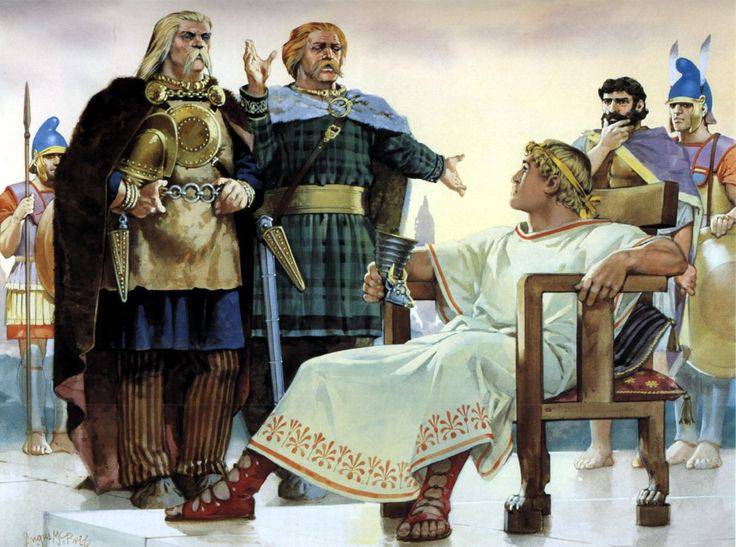
Celtic embassy at the court of Alexander the Great. Having received the ambassadors, he asked them what they were afraid of more than anything, expecting to hear in response that they were afraid of him, Alexander, however, the ambassadors replied: “We are afraid that the sky will fall and crush us, that the earth will open and devour us, that the sea will overflow and absorb us. " That is, the Celts said they were not afraid of anyone. Alexander of Macedon was very angry, but decided that he would have too much honor to fight the barbarians and preferred to start a war with the Persian state. Figure by Angus McBride.
At one time, a very interesting book about barbarians, including the Celts, was written by the English historian Timothy Newark. It was called "Barbarians" *, and the drawings for it were made by the famous British artist Angus MacBride (unfortunately now deceased).
Then in the IV. the Gauls subjected to regular raids on the land of central Italy. Etruscans, Latins and Samnites had to make a lot of effort to repel the Gallic threat, but it did not completely disappear. Perhaps, only the Romans managed to cope with the Celts. To this end, they conducted their mass beatings in northern Italy, and in Spain, and in France. The valley of the Po River they cleared of the Celts after the war with Hannibal and, therefore, that in the middle of the II century. BC. Polybius of the Celts said that only "in few places beyond the Alps" the Celts still remained.
Unfortunately, most of the information about the Celts comes from their enemies - the Greeks and also the Romans, so you can trust her, but ... with caution. In addition, it is very often very specific properties. For example, the Sicilian historian Diodorus describes the Celts as warriors wearing multi-colored clothing, with long mustaches and hair that they drench in the lime so that they stand upright like a horse's mane. But agree that a lot of this information does not squeeze!
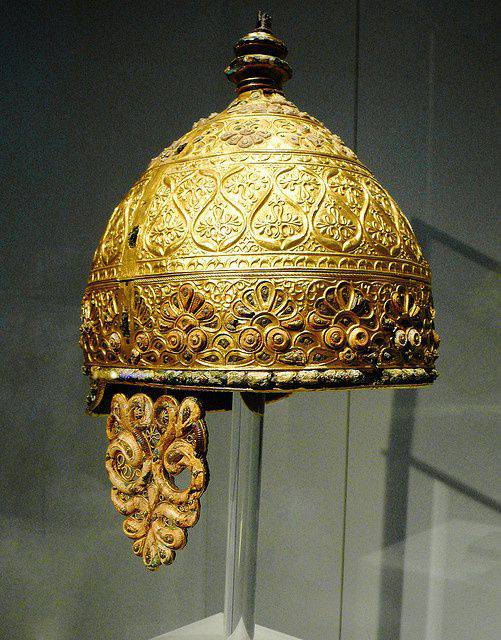
Celtic helmet. France, around 350 BC Archaeological Museum of the city of Angouleme. This impressive work of art was buried in a cave in western France. The entire helmet is covered with a thin gold leaf and decorated with coral inserts.
At first the Romans were very afraid of the Celts, who also seemed to be giants because of their height. But then they recognized their weak points, learned to use them, and began to treat them with disdain. But no matter how great this contempt was, the Romans recognized that led by a good commander the Celts could be excellent warriors. After all, it was they who made up half the army of Hannibal, which, in turn, for 15 years had won victories over the legions of Rome one after another. And then the Romans themselves realized how valuable these people are and for centuries they joined the ranks of their army.
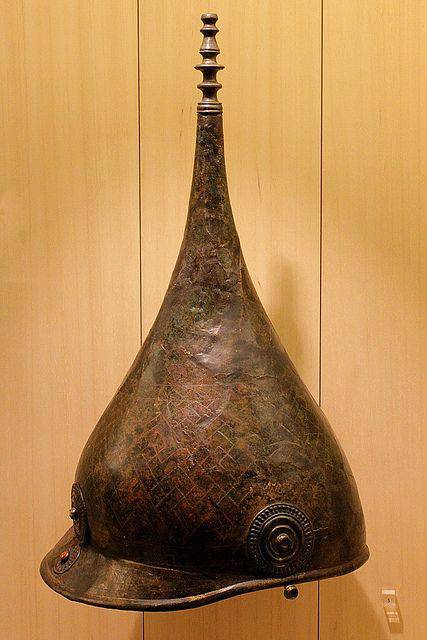
Bronze helmet from Somme peat bogs. Museum Saint-Germain, France.
As is known, many early societies had a warrior class. The Celts, too, were no exception to this rule. They had warriors who came from the middle and upper layers of society. They were given the right to fight, while the poor, according to Diodorus of Sicily, were either squires or operated war chariots and no more.
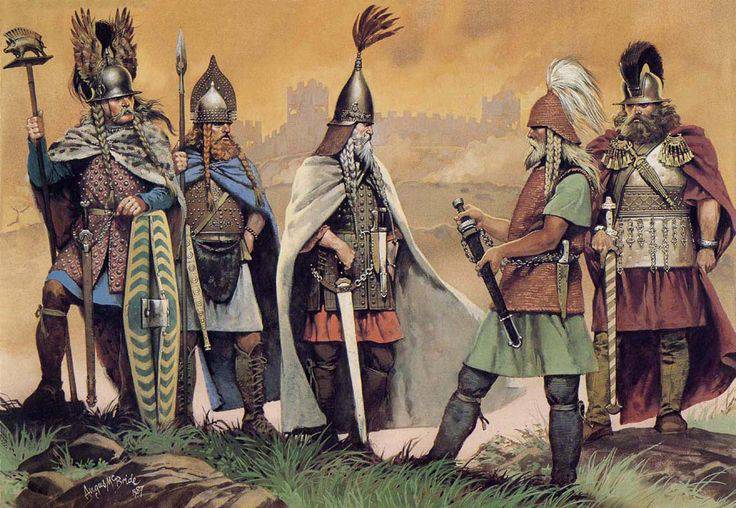
Celts. Figure by Angus McBride.
Moreover, the Celt was a warrior in the most direct and heroic sense of the word. His whole life was viewed solely from the point of view of personal participation in the war and victories won in it in order to prove his courage and win fame on the battlefield. But unrestrained courage in the absence of military discipline often led the Celts to heavy defeats.
In the fifth book of his work, Diodorus gave a detailed and, most likely, fairly accurate description of the Celt warrior. But here it must be remembered that 350 years have passed between the first clash of Rome with the Celts at the battle of Allia and the conquest of Gaul by Caesar - the time that Diodorus described - that is, a whole era. A lot has changed in weapons, and in battle tactics. So again, trust Diodorus one hundred percent should not be!
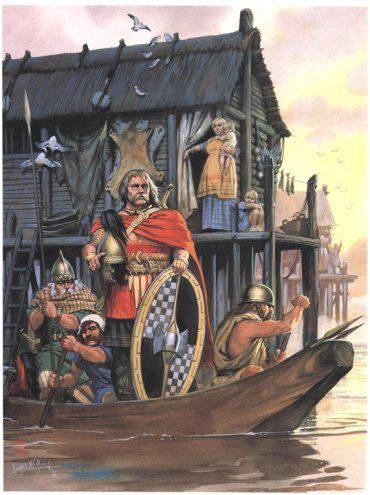
Celts from the pile settlement. Figure by Angus McBride.
Whatever it was, but along Diodorus, the Celtic warrior was armed with a long sword, which he wore on his right side on a chain, and besides him with a spear or throwing darts. Many warriors fought naked, while others, in contrast, had chain mail and bronze helmets. They are often decorated with chased figures or plates with images of animals or birds. He could have a long, as tall as a man, shield that it was customary to cover with relief bronze ornaments.
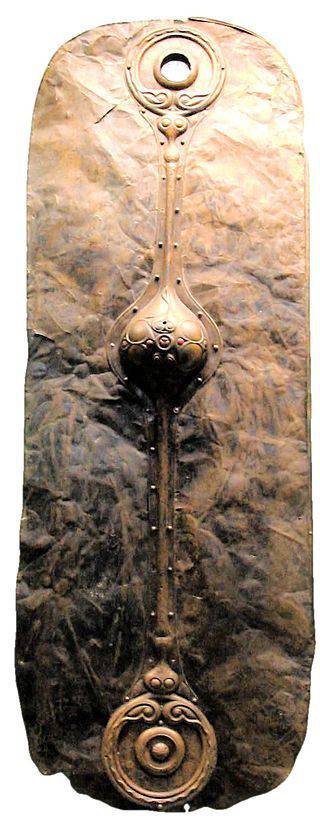
"Shield of Whitham", 400 - 300 BC. er Culture La Ten. The shield was found on the Witham River in the vicinity of Lincolnshire, England in 1826. Further excavations revealed artifacts such as a sword, a spear, and part of a human skull. The shield is now in the British Museum.
In the battles with the enemy cavalry, the Celts used two-wheeled war chariots. Entering into battle, the warrior first threw darts at the enemy, after which, like the heroes of Homer, he went off the chariot and fought with the sword. The bravest warriors began the battle, in turn calling the bravest opponent to the doubles match. If the challenge was accepted, his instigator could sing a laudatory song in front of him, and show the enemy his naked ass, so that everyone could see that he so despised him.
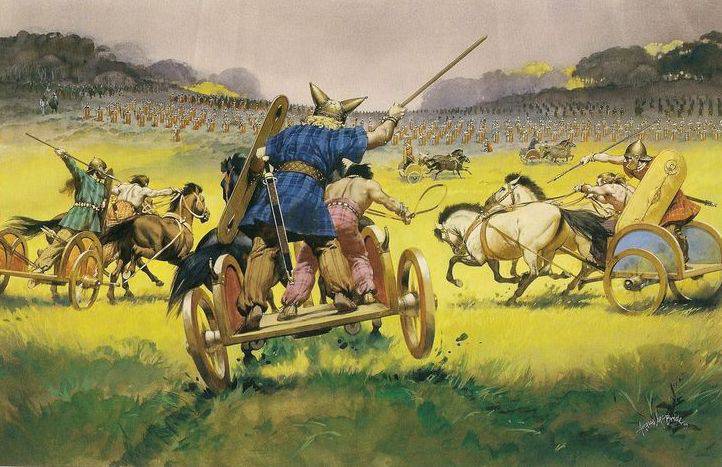
Celts on chariots. Figure by Angus McBride.
The Romans highly honored those of their generals who accepted such a challenge and won in such a single duel. They were given the honorable right to dedicate the best part of the war booty to the temple of Jupiter Feretrius ("Giver of Mining" or "Bearing Victory"). There were also the second and third part of the dedicated loot, which were also dedicated to the gods, but this already depended on the rank of the winner. For example, in the IV. Titus Manlius defeated a huge Celt in the battle and, tearing the golden hryvnia (torkves) from his neck, earned it the nickname Torquat. And Marcus Claudius Marcellus in 222 BC. killed in a duel of the Gallic leader Viridomar.
Well, if the Celtic warrior killed his opponent, he cut off his head and hung it on the neck of his horse. Then the armor was removed from the slain, and the winner sang a victory song over the enemy's corpse. The captured trophies could be nailed to the wall of his home, and the severed heads of the most famous enemies even embalmed in cedar oil. For example, the Celts acted with the head of the consul Lucius Postum, who was killed by them in 216, which was then exhibited in their temple. The excavations in Entremont proved that such heads were not just trophies, but also part of a religious ritual, as they were located in certain places and were clearly used for religious purposes.
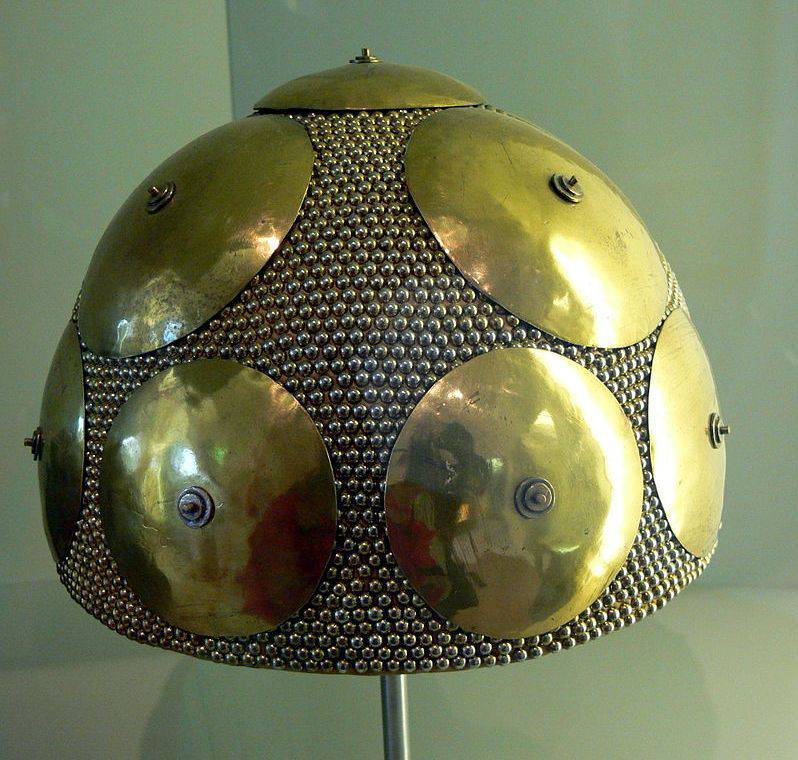
"Helmet of Linz" (reconstruction). Linz Castle Museum (Upper Austria). Hallstatt Culture, 700 BC
At the same time, absolutely all ancient authors are unanimous in that the Celts did not value strategy or tactics, and everything they did was influenced by momentary motives, that is, the Celts had the so-called ochlocracy or mob power. In battle, they also acted in mobs, although the presence of pipes and standards, depicted in particular on the arch in Orange, shows that, at least, they had a military organization. So, Caesar, in his Notes on the Gallic War, writes about how the pilums of the Roman legionnaires pierced the closed rows of Celtic shields - an impossible situation if the enemy pounces on you in a "crowd." That is, the Celts should have had some sort of phalanx, otherwise where could the “rows of shields” come from?
Thus, it turns out that the Celts were not so "wild" and knew the correct construction on the battlefield. In the battle of Telamon, as Polybius writes about it, they were attacked from two sides, but they didn’t get confused, but fought in four men, deployed in both directions. And the Romans were frightened by this impeccable system, and the wild rumble and noise that the Celts made, having countless trumpeters, and their warriors also shouted their battle cries. And then Polybius says that the Celts were inferior to the Romans only in arms, as their swords and shields were inferior in quality to the Romans.
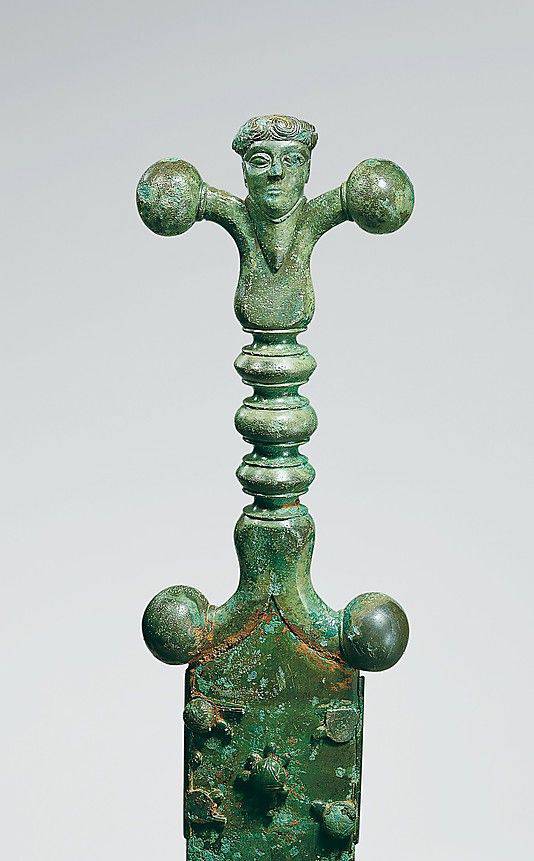
Celtic sword with scabbard, 60 BC. Metropolitan Museum, New York.
The Romans reported four types of Celtic warriors: heavily armed infantrymen, lightly armed infantrymen, horsemen and chariot warriors. And judging by ancient sources, the heavily armed infantrymen are swordsmen, and lightly armed ones are throwers of darts.
Dionysius reports that the Celts tend to raise the sword above their heads, rotate them in the air and bring down the blow on the enemy as if they were chopping wood. This method of working with a sword made a very strong impression on their opponents. But the Romans very soon learned to resist him. So Polybius argues that they took the first blow on the upper edge of the shield, which on Roman shields was reinforced with an iron plate. The Celtic sword, which had a weak tempering, was bent from hitting this edge, so that the warrior straightened it with his foot, and while he did this, the legionnaire could easily attack him! In addition, the chop took time, it could be reflected with a shield and at the same time hit from under his stomach with a thrusting strike, which the Celtic could not reflect.
It is believed that the statement of Polybius, that the sword was bent almost in half - an exaggeration. Sometimes it probably happened, but in general, Celtic swords had good quality. Peter Connolly writes that he saw a sword from Lake Neuchâtel dating back to the time of Polybius, and it was possible to bend it almost doubled, but he immediately assumed his former form. Connolly writes that Polybius mentions the Celtic custom of wearing bracelets in a battle. But if these were bracelets similar to those found in Britain, then this would most likely be possible. It is unlikely that such heavy bracelets would be able to hold onto his hand when the warrior twisted his sword in the air, and then struck them with the strongest slashing blow!
* Newark, T. Barbarians. Hong Kong, Concord Publications Co., 1998.
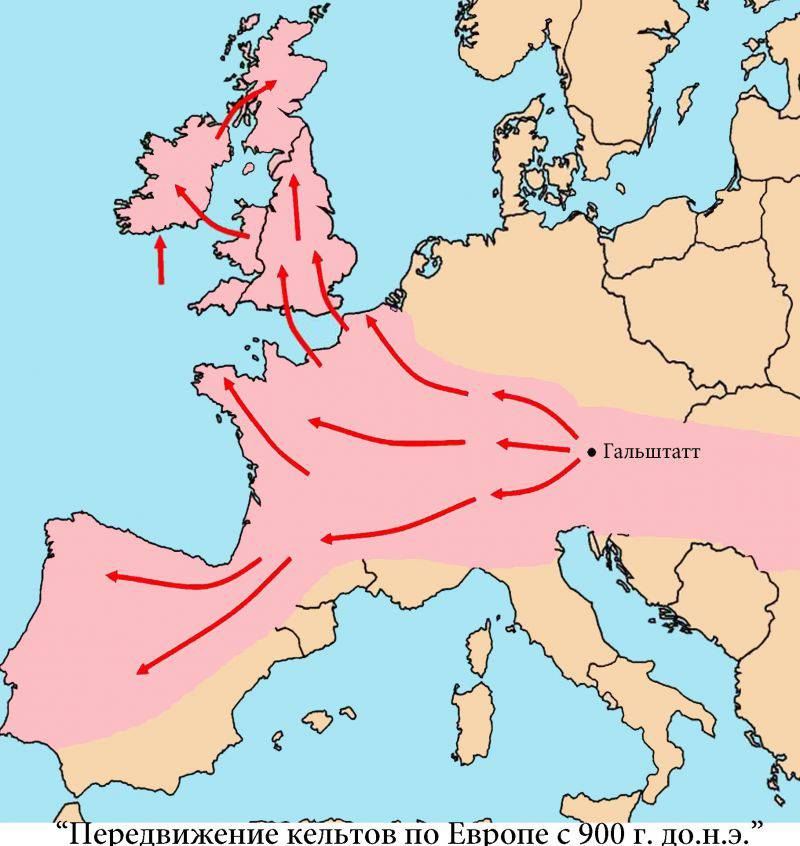
Information